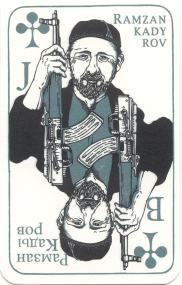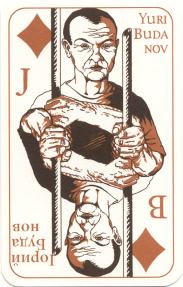
-1-

![]()
-1-
The title of the deck refers to that part of the Caucasus, where Chechen factions still fight a guerrilla war against the Russian army. The idea for the "theatre of pain" linocuts and deck arose after an exhibition of work by the Dutch artist Cerberus in Moscow in 2004. The opening of the exhibition coincided with the massacre in the school in Beslan. Cerberus noticed "a feeling of dismay among many Russians and also the limited and canalized reporting about the hostage taking in Beslan". He has made this deck "to contribute his mite in the wearisome public debate about the civil war in the belly of the Russian Federation".
After the exhibition of the large size linocuts at the Breda Museum in the Netherlands during the summer of 2005, the aim was to organize exhibitions in Jaroslavl, Moscow and St. Petersburg too. The deck was meant to be passed out for free to visitors of the exhibitions there.
|
|
Boris Jeltsin was the first elected president of the Russian Federation from 1991-1999. After Chechnya had declared full independency in 1993, he led the political and military offensive in the first Chechen War from 1994-1996. |
|
|
Aslan Maschadov was elected president of Chechnya in 1997. Before that he was the successful chief of staff of the Chechen army, who forced the Russians to negotiate a peace with him to end the first Chechen War in 1996. His presidency was weakened by his main rival, Sjamil Basajev. Although he had publicly condemned it, after the Beslan massacre the Russian put a 10 million dollar price on his head. He was killed in the bombing of his house by Russian security forces in March 2005. |
||
|
Ramzan Kadyrov is the son of the Chechen president Akhmad Kadyrov, who was assassinated in April 2004. After this Ramzan was appointed Deputy Prime Minister of the Chechen Republic. He leads the Kadyrovtsy, a militia of ca. 3000 men, that forms the internal security force, but is also alleged to be responsible for 70% of the murders, rapes, torture and kidnappings in Chechnya. He is backed by the Russian president Putin because he accepts the presence of Russian troops in Chechnya. |
 |
|
Alexandr Lebed was the general of the Russian Army, who refused to have his tanks fire upon the White House, seat of the Russian Parliament, and released Boris Jeltsin there. Later he was appointed as Chairman of the Security Council and in this position he has led the negotiations with Chechen president Aslan Maschadov, and signed the Khasavyurt Agreements, which ended the First Chechen War in August 1996. He was killed in a helicopter crash in 2002. |
Although this deck is definitely a "political" deck, in our opinion the artist doesn't really take sides. And if he does, it's probably for the Queens, all being a victim of this war in some way. Cerberus presents the depicted combatants as he sees them. All the Chechen leaders carry guns and Sjamil Basajev is depicted holding a skull, like a ruler about life and death. The Russian participants may not carry guns, but the proverbial cannibalism of Boris Jeltsin and cool calculating of Vladimir Putin as architect of the second Chechen War have been depicted merciless.
|
|
Anna Politkovskaja was a
Russian journalist who wanted to intermediate in the Beslan hostage
conflict. The FSB poisoned her on her way over there. |
The Black Widows are the
Chechen women, who have lost their husbands in the war. They have nothing left
and often volunteer as
suicide bombers. |
|
|||
|
She was killed in Moscow on 7 October 2006. |
Since the hostage horror in the Moscow musical theatre in
2002 the
Russian authorities have decided that a press-blockade would be the effective
way to fight this terrorism, on the presumption that these groups are only out to get
attention. So there are hardly any pictures or footage of Chechen rebels to be
found in the Russian media.
The publication and exhibition of these icons of the
Chechen wars was obviously a bridge too far for some authorities: two shipments,
totaling 120 decks and some original lino-cuts, to the museum in Jaroslavl were confiscated by the
FSB (Federalnaja Sloezjba Bezopasnosti), the Russian secret service,
formerly known as the KGB.
|
|
Sjamil Basajev has lead a hostage taking at a hospital in the southern Russian town of Boedjonnovsk in 1995 and he has also claimed responsibility for organizing the hostage taking at the Moscow theatre in 2002, the assassination of the Chechen president Achmad Kadyrov in 2004 and the hostage taking of school children in Beslan in 2004. Once he was Deputy Prime Minister of Chechnya, but now he's Russia's most wanted man and there's a 10 million dollar price on his head. |
|
|
Vladimir Putin was elected as second president of the Russian Federation in March 2000. Before that he was chief of the FSB and later prime minister under Jeltsin. He initiated the second Chechen War in 1999. Although most of the fighting ended in 2002, that war still goes on........ |
||
|
The bar that Yuri Budanov is holding represents the 10 years prison sentence that was given to this colonel in the Russian Army by the Northern Caucasus military court in August 2003. This sentence overruled the initial verdict by another military court in December 2002, that had cleared colonel Budanov, as he was found to have been "temporarily insane" at the time that he had raped and killed a Chechen teenage girl. |
 |
|
Movsar Barajev was the Chechen leader of the group that took ca. 600 hostages at a theatre in Moscow in October 2002. After his uncle Arbi Barajev, aka the "Terminator", was killed in 2001, Movsar became leader of the "Islamic Regiment", one of the many Chechen militias. The FSB had pronounced his death several times before, but were never able to proof this until he was killed in the Moscow theatre. |
More details about this publication can be found on the next page.